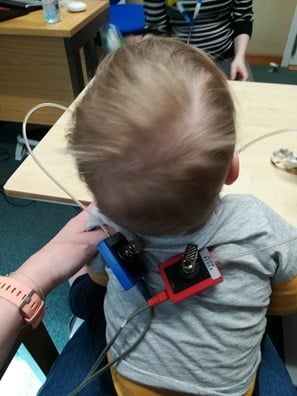The assessment process for cochlear implantation
Published Date: 18 Aug 2022
Cochlear implants (CIs) were first mentioned to us as a possibility when Lucas was diagnosed at eight weeks. Fast forward 10 months and Lucas has now had his surgery and we’re eagerly anticipating his activation appointment next week. Our experience of the process to get here has been really positive, and while I know this isn’t always the case, and all implant centres differ slightly, I thought it might be useful to outline the different stages that we went through.
It is no small thing to choose cochlear implantation for your child. It’s an incredibly expensive bit of kit for the NHS, a lifetime commitment for the user, and an invasive surgery for a little one. It’s understandable, therefore, that the NHS conduct a thorough assessment to ensure they are absolutely necessary. The process aims to give parents factual and emotional support, as well as thoroughly assessing the child’s hearing levels and ear anatomy.
The first thing we had to do was confirm that we wanted a referral to the cochlear implant centre. Lucas’s hearing loss was significant enough at diagnosis that this was offered to us early on, and even though we wanted to see how Lucas got on with his hearing aids, it made sense to start the assessment process in parallel so that we had options further down the line. A few months later we met with an ENT consultant and with the team at the implant centre for an opportunity to ask any questions and be talked through everything.
They had to determine if Lucas’s ear anatomy was suitable for implantation, and so he had an MRI when he was six months old. He needed oral sedation to ensure he didn’t wriggle around too much, which was fine. I was able to stay with him next to the MRI machine, and it was over in about half an hour. We had to wait about two months for the results which confirmed that while he was thankfully a surgical candidate, with working auditory nerves, he did have deformed cochlears (Mondini) and enlarged vestibular aqueducts, both of which presented a few additional but not insurmountable complications. We also learnt that any hearing he did have would be likely to deteriorate over time.
Lucas also had behavioural hearing tests. Unlike auditory brainstem response (ABR) tests, the behavioural tests aimed to determine his conscious response to sounds by observing him turning his head when a sound was played into his ears from the audiologist’s computer. He seemed to enjoy the tests and happily sat on my lap the whole time. The tests confirmed that Lucas’s hearing was 80-100DB across the four main speech frequencies which put him in criteria for cochlear implantation.
All of this, along with anecdotal information provided by our Teacher of the Deaf was then discussed by a multidisciplinary team at the hospital a week later, and we received a detailed letter summarising their joint recommendation which was for Lucas to have cochlear implants. The ball was very firmly in our court to decide if this was something we wanted to progress with - there was never any pressure placed on us. An appointment with the surgical consultant was made for a week later, and it was here that we would need to make our choice and sign the consent forms.
We found a really supportive Facebook group called ‘Parents of Children with Cochlear Implants’ and joined the Cochlear Implanted Children’s Support Group (CICS) who put us in touch with other parents of CI kids. We also spoke to our local deaf support worker to understand her perspective, and after a lot of deliberation and lists of pros and cons, we decided to go ahead and went on the waiting list.
The process from referral to surgery took eight months. It was lengthy, but we felt supported and informed all the way through.
